Uncertainty Management in LOGiCAL Ecosystem
Introduction
The Uncertainty Management feature in the LOGiCAL ecosystem allows users to apply an uncertainty configuration to an instrument. This configuration is considered when determining the pass/fail status of a calibration in supported mobile solutions. Users have extensive configuration options for managing uncertainties and defining when they are required.
Uncertainty budgets are maintained outside LOGiCAL (e.g., in an Excel spreadsheet). The calculated uncertainty value can then be entered into LOGiCAL. Considering uncertainty in calibration is essential to ensure compliance with required specifications, improve confidence in results, and support the quality of products and services.
A simplified workflow for uncertainty management in LOGICAL and supported mobile solutions (bMobile application, MC6 family calibrators):

Enabling Uncertainty Management
Uncertainty management can be enabled in the Organization settings under Calibration by the organization administrator or a user with the suitable permissions.
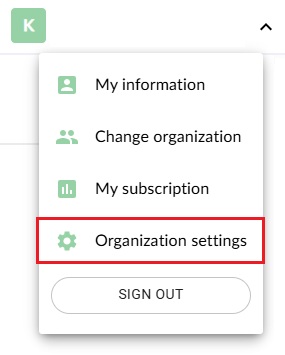

Uncertainty can be required for all instruments or based on the custom fields defined for the instrument. The conditions can be specified under which uncertainty must be included for an instrument before it can be calibrated. This validation is performed before instrument is assigned for calibration.
| Uncertainty management setting | Description |
|---|---|
| Disabled | The feature is disabled – default setting. Uncertainty cannot be configured for instruments |
| By custom field, no custom fields selected | Uncertainty is not required but can be configured for instruments |
| By custom field, one or more custom fields selected | Uncertainty is required for instruments where any of the selected custom fields are enabled |
| Required for all instruments | Uncertainty is required for all the instruments before they can be assigned for calibration |
Defining Uncertainty for Instruments
Uncertainty budgets are maintained outside LOGiCAL (e.g., in an Excel spreadsheet). The calculated uncertainty value can then be entered into LOGiCAL. Users can apply a predefined uncertainty rule or enter a specific uncertainty value for an instrument. Using uncertainty rules is optional but helps to maintain consistency and ease of maintenance when the same rule is applied to similar instruments. The uncertainty rules can be available for the entire organization or specific to a single plant. It is also possible to apply uncertainty rules for instruments in larger batches.
Note! While uncertainty values can also be added directly to the instrument’s configuration, using uncertainty rules provides a centralized, harmonized and more flexible method for managing uncertainties.
Uncertainty Rules
Uncertainty rules are maintained under Lists / Uncertainty rules.
Note! Requires a permission to create and update Lists. See Roles and Permissions.
The Lists / Uncertainty rules view displays the uncertainty rules that are available for the logged in user. The uncertainty rules can be made available for the entire organization or specific to a single plant.
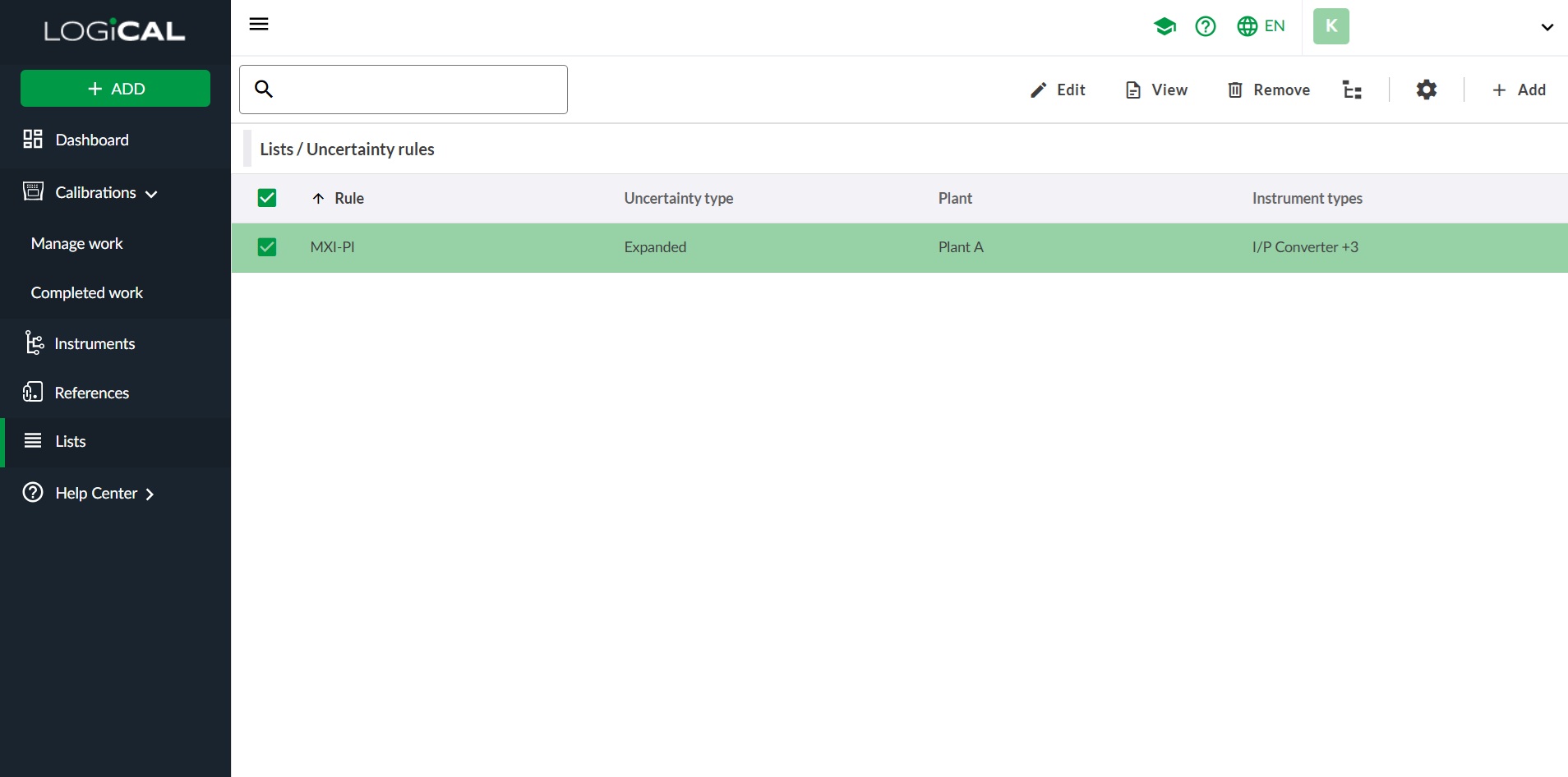
Adding a New Uncertainty Rule
You can add a new uncertainty rule by clicking in the top right corner.
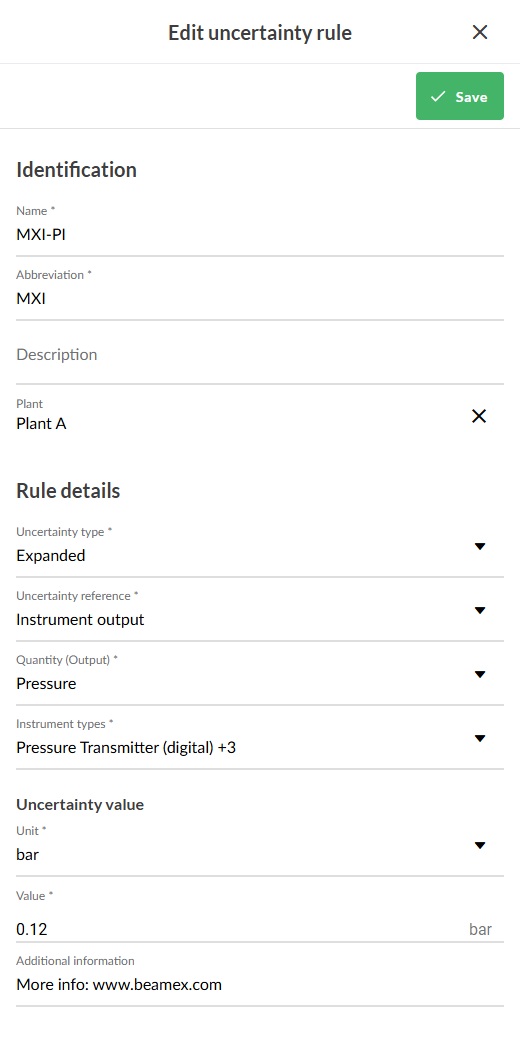
| Field | Description | Note | |
|---|---|---|---|
| Identification | Name* | Name of the uncertainty rule | Customers should think about the naming convention within their organization for easy identification |
| Abbreviation* | Used to map an uncertainty rule with an instrument when importing instrument data. The abbreviation value must be unique throughout the organization | ||
| Description | Description for the rule | ||
| Plant | Used to limit the availability of a rule to a specific plant (highest level node in the plant structure). If no plant is selected, the uncertainty rule is available for the entire organization | ||
| Rule details | Uncertainty type* | Currently only “Expanded” is supported | Used for future expansions of the feature |
| Uncertainty reference* 1 | Input, output or projected input | Must match the instrument’s error reference value | |
| Quantity* 1 | Input or output quantity of the instrument (depending of the uncertainty reference selection) | ||
| Instrument types* 1 | Which instrument types will this rule be compatible with | ||
| Unit* 1 | Unit of the uncertainty value | Uncertainty value’s unit does not have to match instrument’s unit. The uncertainty value will be presented in the instrument view with this unit, but the value will be converted in the mobile solutions to match the unit used in the instrument. | |
| Uncertainty value | Self-explanatory | See Unit above | |
| Additional Information | Any other information that you want to pass on to the calibration technician | This can also be a hypertext link, pointing to your organization’s documentation, where the uncertainty value has been defined. |
Once an uncertainty rule has been created, it can be applied to instruments that are compatible with the rule. See Instrument Management – Add Uncertainty to an Instrument how the uncertainty rule is applied to an instrument.
Editing an Uncertainty Rule
Uncertainty budgets may be updated from time to time, and the uncertainty value may have to be edited. Instead of changing the uncertainty value at every instrument, it is enough to edit the value in the rule, and all instruments linked with the uncertainty rule will automatically inherit the updated value.
Editing the uncertainty value is done by selecting an uncertainty rule and clicking either on the context menu or the toolbar.
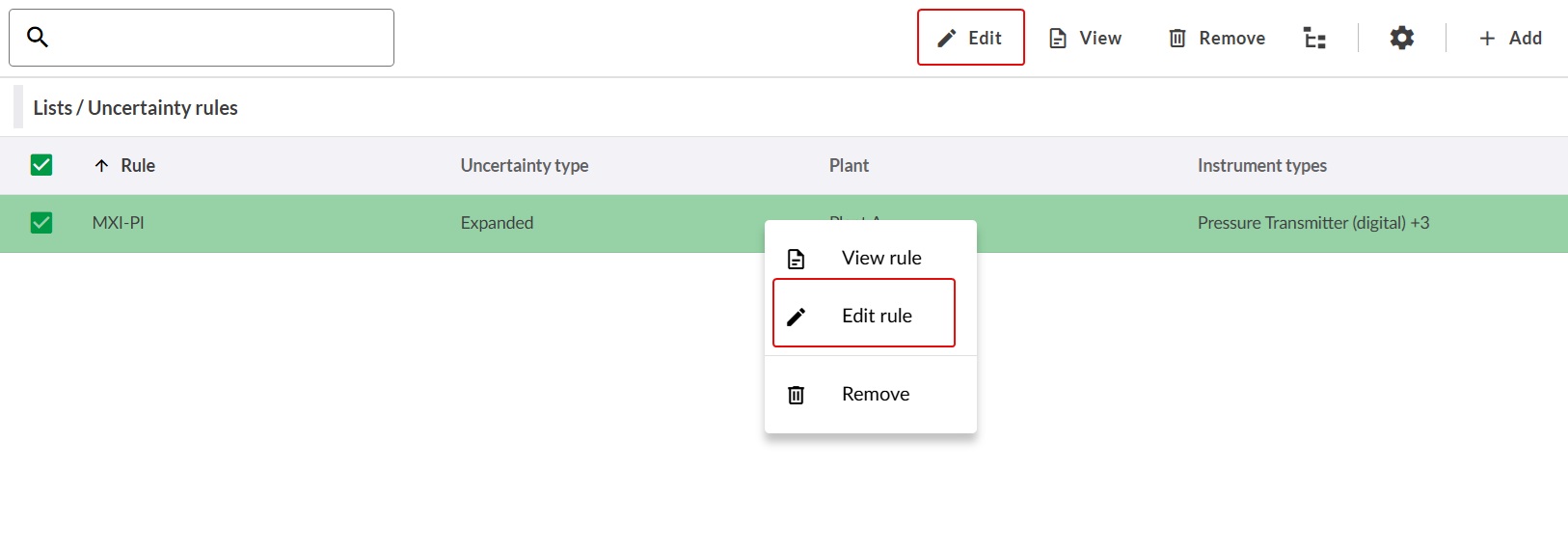
Note! After applying uncertainty configuration for an instrument, it is not possible to edit the fields that are part of the rule-to-instrument mapping, such as quantity or uncertainty reference.
Instrument Management – Add Uncertainty to an Instrument
Uncertainty can be applied to an instrument by using Uncertainty rules or by entering the uncertainty value directly into the instrument configuration.
Once an uncertainty configuration is applied to an instrument, certain instrument level fields (e.g. input and output quantities, output category and error reference) are locked out from editing, to prevent users from changing the instrument in a way that would make the uncertainty configuration invalid for the instrument. If changes need to be made for these fields, you can remove the uncertainty configuration from the instrument, make the necessary changes and then applying a suitable uncertainty rule.
Uncertainty is configured to an instrument in the procedure tab.
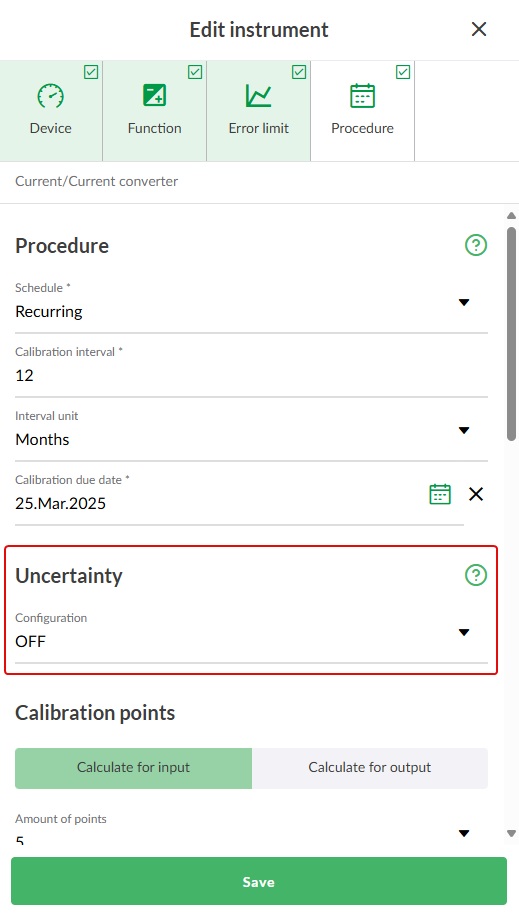
The available configurations are:
| Uncertainty | Description |
|---|---|
| Off | No uncertainty configuration. |
| Uncertainty rule | Use a pre-defined rule that is compatible with the instrument. |
| Uncertainty value | Enter an uncertainty value directly to the instrument configuration. |
Apply an Uncertainty Rule to an Instrument
If you want to apply an uncertainty rule for the instrument, you need to choose the rule from compatible uncertainty rules. See Adding an Uncertainty Rule for the mapping between the uncertainty rule and the instrument configuration.
Once the Rule has been selected, the key information of the uncertainty rule is presented as part of the instrument configuration.
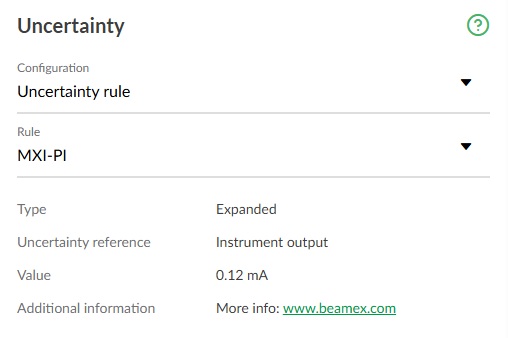
Apply an Uncertainty Rule to Multiple Instruments
An uncertainty rule can be applied to many instruments also. In the instruments view, you can e.g. use the filter functionality to search for instruments meeting the criteria. Select the instruments you want to apply the uncertainty rule for and right click to open the context menu.
Choose Configure uncertainty.
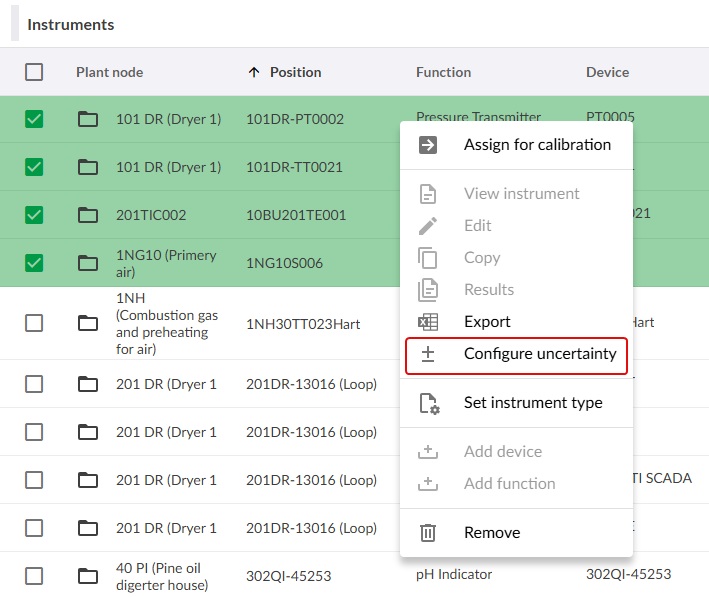
The opening Uncertainty configuration window groups instruments based on their instrument type and error reference.
Uncertainty configuration can be set to a single instrument or set the same rule for all matching instruments from .
Note! Individual uncertainty values cannot be entered through this view.
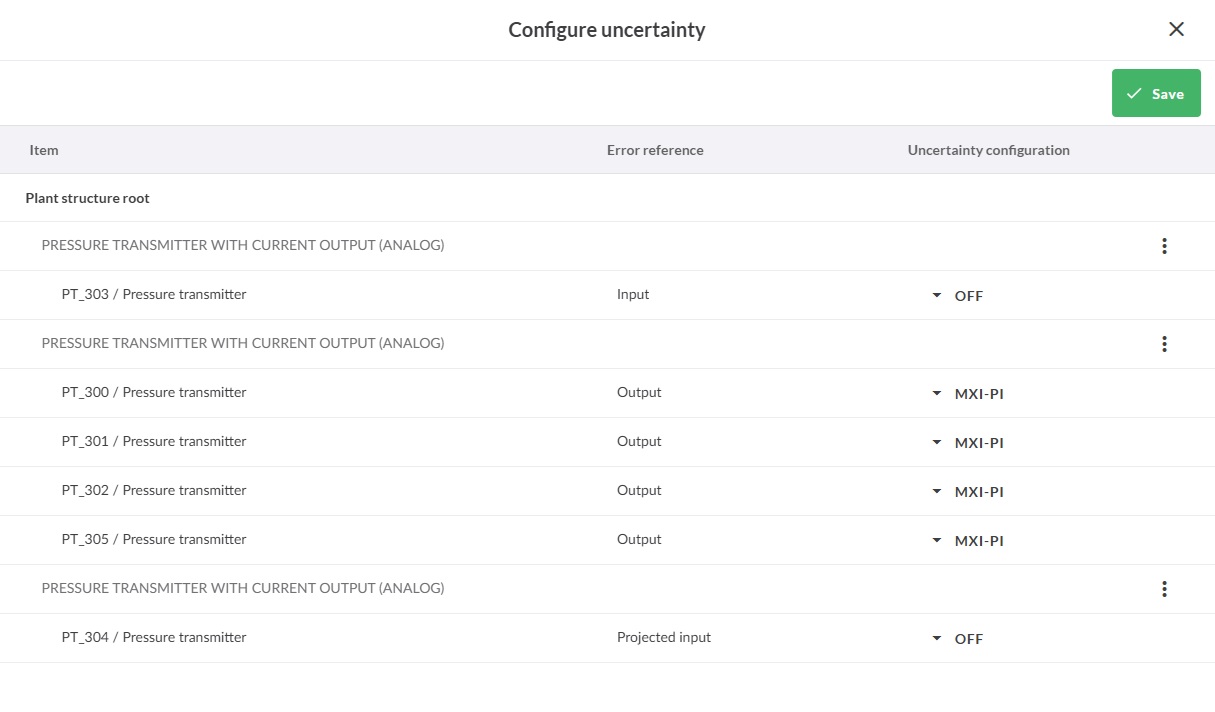
After choosing the suitable uncertainty configurations, save the changes.
Use an Uncertainty Value
In the procedure view of the instrument editor, you can enter an individual Uncertainty value. The unit will be the same unit as the instrument input or output function (depending on the error reference selection).
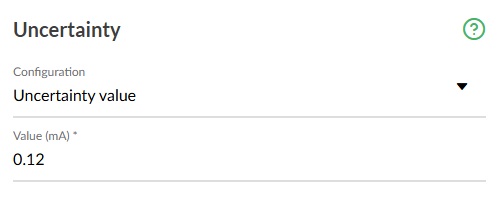
Apply Uncertainty to Instruments by Using Import Tool
Instrument Data Export
When exporting instruments to Excel spreadsheet, the export file contains information of the instrument’s uncertainty configuration, either with the linked uncertainty rule abbreviation or the uncertainty value defined for the instrument. These can be found under fields “uncertaintyAbbreviation” and “uncertaintyValue” respectively.
Instrument Data Import
Uncertainty configuration can also be imported or updated using the import tool. Uncertainty value for an instrument can be added in the Excel spreadsheet. The unit of the value is taken from the instrument configuration, specifically from the error reference (“errorCalcSide” -field in the spreasheet). When working with uncertainty rules, you can add the uncertainty rule’s abbreviation in the Excel spreadsheet.
Note! The uncertainty rules must to be created in LOGiCAL before they can be used with the import tool.
When importing the spreadsheet, LOGiCAL will validate the uncertainty rule’s compatibility with the instrument being imported and validation fails if the uncertainty rule is not compatible. the uncertainty rule (uncertaintyAbbreviation field) is validated as follows:
- The imported instrument’s first plant structure level must align with the uncertainty rule’s plant information (“PositionPath” -field in the import file must match the “Plant” field of the uncertainty rule).
- The imported instrument’s error reference (“errorCalcSide”) must correspond to the “Uncertainty reference” field of the uncertainty rule. This means whether error is calculated for input,output, or projected input.
Furthermore: The instrument type is not part of the import data. LOGiCAL will interpret the instrument type based on the imported instrument and the uncertainty rule must be defined for the same instrument type. Since instrument type is not used in data import, we cannot determine the exact instrument type when creating an instrument via Excel spreadsheet. This means that if the given input/output quantities and output category match multiple instrument types, we cannot change the instrument type. As a result, validation is not overly strict in such cases.
For example, if a user creates an instrument with a Pressure quantity, it may have multiple possible instrument types. The validation will pass if the rule has at least one compatible instrument type selected. However, if the user creates an instrument with different quantities, such as temperature quantities, and no matching instrument types are found, a validation error will be displayed.
Note!
If you change the instrument using the Excel spreadsheet in a way that the linked uncertainty rule is no longer compatible, the uncertainty information will be removed from the instrument during import. The import tool cannot validate the uncertainty rule compatibility in these cases.
Note!
If you remove the uncertainty related columns, or empty the fields, the import considers uncertainty to be removed from these instruments during import.
Instrument Management -view configuration
You can configure the instrument management -view by activating “Uncertainty configuration” -field in the column configurator to also show the uncertainty associated with each instrument:
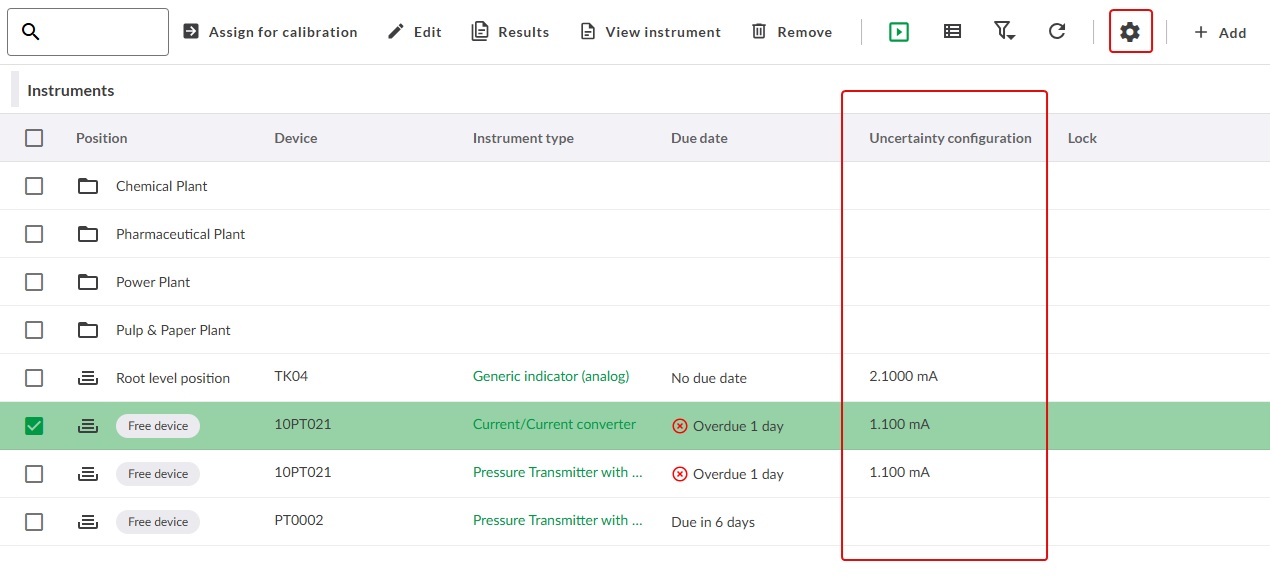
Calibration Process
When the instrument is assigned for calibration, its uncertainty configuration becomes a part of the instrument data sent to supported mobile solutions.
Assigning Instruments for Calibration
Assigning instruments for calibration is done the same way as normally.
If uncertainty has been defined as required in the organization settings, the instrument cannot be assigned, unless an uncertainty configuration has been specified. An error message is provided for the user of the lacking uncertainty in the Assign for calibration sidebar.
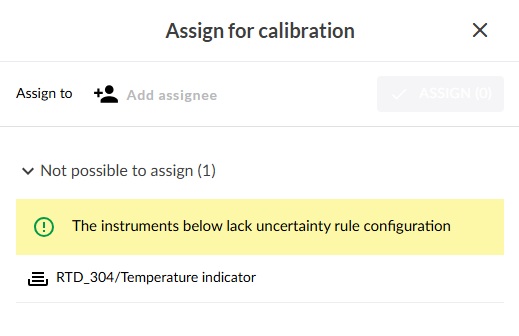
Calibration Process with Mobile Solutions
The uncertainty management is done in LOGiCAL. You are not able to edit the uncertainty in the mobile solutions.
- Uncertainty with MC6 Family Calibrators
- Uncertainty with bMobile Application
After opening the documenting calibrator mode, the instrument and its uncertainty configuration can be viewed by clicking the settings icon.
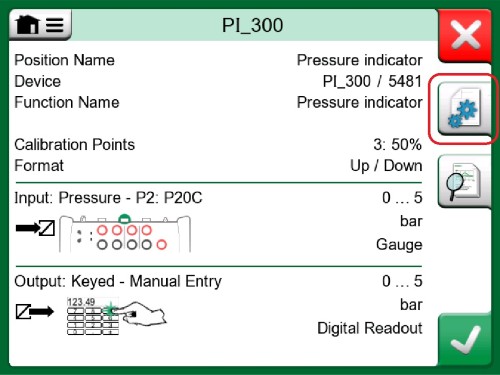
The uncertainty value is presented as read only and cannot be edited.
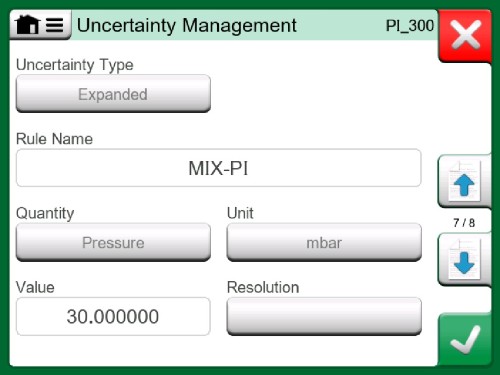
Note! This page is only shown for instruments that have uncertainty configured.
During calibration, the uncertainty is shown to the user together with the error. If the uncertainty component exceeds the error limit, a calibration point is considered as failed (This is also called the binary decision).
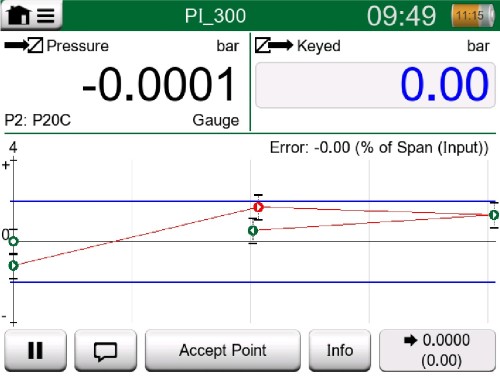
The Calibration summary page includes uncertainty (converted to the instrument’s error unit).
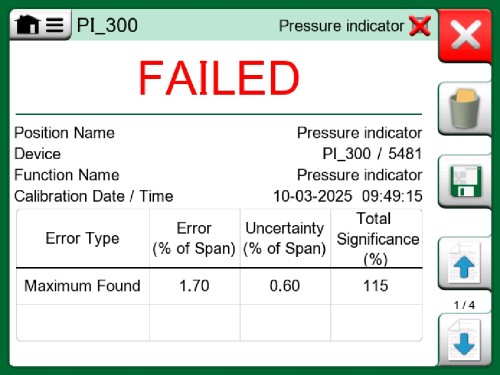
The result table also includes the uncertainty and significance. Significance is calculated using the error + uncertainty value.
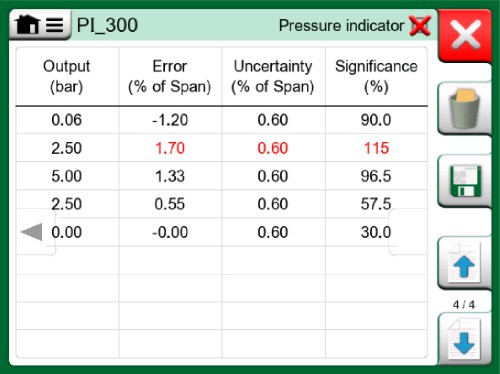
Note! You need to click the arrow keys right or left to see all columns in the table.
After saving, results can be synced back to LOGiCAL normally.
After syncing the assigned instrument to bMobile, the instrument and its uncertainty configuration can be viewed in the instrument viewer.
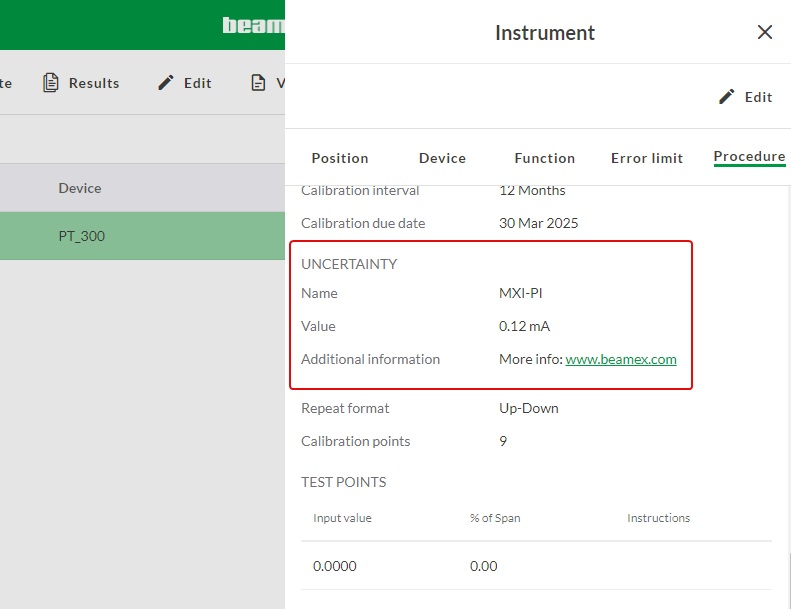
Note! The uncertainty information is only shown for instruments that have uncertainty configured.
If a user has edit permissions to the instrument, the uncertainty value is presented as read only and cannot be edited in bMobile.
During calibration, the uncertainty is shown to the user together with the error. If the uncertainty component exceeds the error limit, a calibration point is considered as failed (This is also called the binary decision).

The Calibration summary page includes uncertainty (converted to the instrument’s error unit)
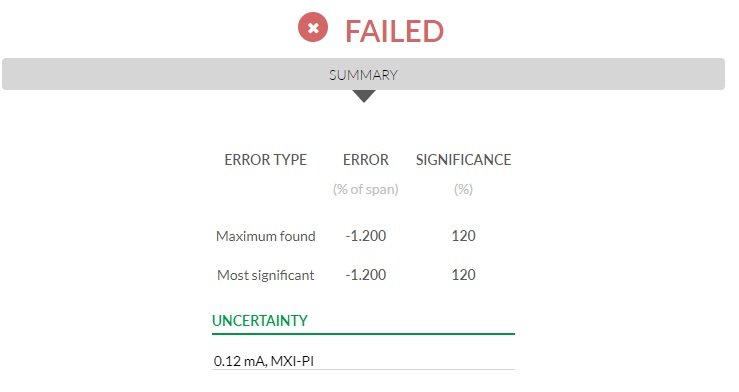
The result table also includes the uncertainty and significance. Significance is calculated using the error + uncertainty value.
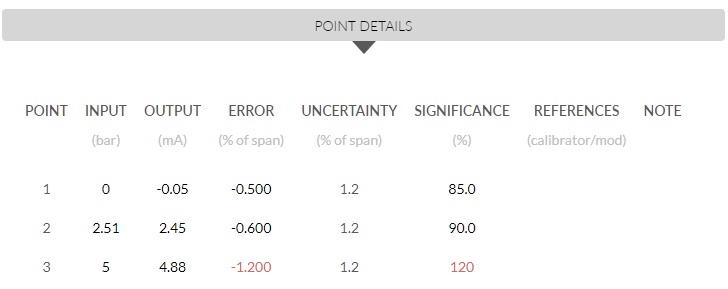
After saving, results can be synced back to LOGiCAL normally.